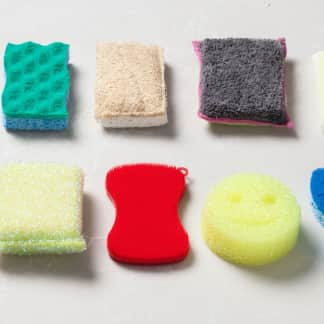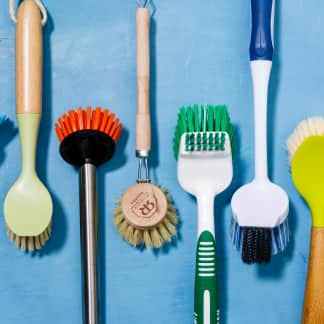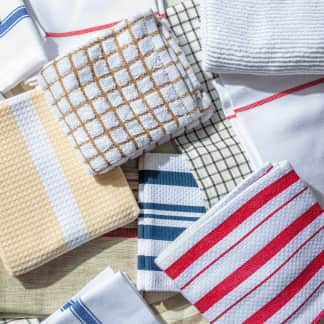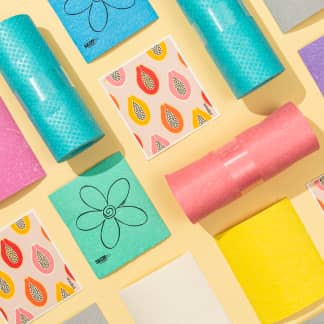We tested dish soaps and foaming dish sprays, and we think dish soaps are the better products for everyday dish-cleaning. Testers were impressed by the cleaning power and pleasant fragrance of Method Dish Soap, which we’ve named as our Best Dish Soap. If you’re concerned about reducing pollution, opt for our Best Plant-Based Soap, Grove Collaborative Dish Soap. Though we think they’re less versatile, we did find foaming dish sprays to be especially efficient at removing tough, cooked-on messes. Our favorite dish spray is Dawn Platinum Powerwash Dish Spray.
You might use dish soap every day, but have you ever thought about what’s in it or how it works? Dish soaps’ grease-fighting power comes from surfactants: tadpole-shaped molecules with water-loving heads and oil-loving tails that encourage water and fats to mix. Surfactants make it easier for water to penetrate, envelop, and loosen food remnants from the surfaces of dirty dishes, helping you scrub and rinse all that food mess down the drain.

Surfactants have made dish soap the MVP of kitchen cleaning for more than 70 years, but the last decade has seen the advent of a new type of dish cleaner: foaming dish spray (also known as “power-wash,” after brand Dawn’s popular spray). Dish sprays have a foaming nozzle that transforms their liquid formula into a thick lather of suds as you spray. The suds coat your dirty dishes and break down food residue, which you then scrub and rinse away. Foaming sprays contain additional active ingredients such as ethanolamine, which manufacturers claim work quicker and more effectively than the simple surfactants in normal dish soap. We included dish sprays in our lineup to see whether they were just a fad or advantageous over regular dish soap.

Petroleum or Plants: What’s Your Dish Soap Made From?
The surfactants in dish soaps and foaming sprays originate from two main sources: petroleum and plants. Dish soap manufacturers have used petroleum-based surfactants in their products for decades; some of the most popular traditional dish soaps, including those from Dawn and Palmolive, contain them. However, their use is controversial for two reasons. First, petroleum is a nonrenewable resource, and processing it releases greenhouse gasses and contributes to climate change. Second, research shows many petroleum-based surfactants are harmful pollutants; they’re slow or unable to biodegrade, and they can be highly toxic to aquatic ecosystems.
You Should Be Marinating Your Dishes
This science-based trick makes dish duty a little less tedious.Given the widespread public concern about petroleum-derived soaps, manufacturers have begun crafting dish soaps and foaming sprays with plant-derived surfactants (also referred to as “plant-based surfactants” or “biosurfactants”) instead. Plant-derived surfactants are produced more sustainably, using natural sugars or oils from plants, such as coconuts, rather than nonrenewable petroleum. They’re also usually more biodegradable, which means they break down in water instead of lingering and harming the environment.
Interested in whether plant-based soaps and sprays work as well as petroleum-derived products, we tested products made from each source. Our tests revealed that soaps and sprays made with surfactants from plants worked equally well to clean our dishes compared to products made with petroleum-based surfactants. We verified these results with Dr. Brian Grady, the director of the University of Oklahoma’s Institute for Applied Surfactant Research, who corroborated that petroleum-based and plant-based surfactants usually perform similarly. A few factors did affect which soaps and sprays we liked better, which we’ve outlined below.
What to Look For
- Powerful Formulas with Lots of Surfactants: All the soaps and sprays we tested were able to clean our dishes well. A few products required slightly less time and scrubbing from us to do so. We were interested in what set the standouts apart, so we set up a scientific “wetting” test. The test evaluated how well the products’ surfactants worked to help water spread across paper strips (a hydrophobic, or water-repelling, stand-in for kitchen grease). For the most part, soaps and sprays that worked better on dishes also performed better in this test, indicating they contained high concentrations of powerful surfactants that worked quickly to dislodge food residue. Manufacturers don’t disclose their formulas, but Grady agreed that the most important factor for determining how well a soap cleans is its surfactant concentration and strength, rather than the source of the surfactants.


- Pleasant Scents or Unscented Products: We recruited a panel of testers to smell and evaluate the soaps’ and sprays’ scents, and we found no real pattern to their preferences. Some loved strong, synthetic-smelling scents; others enjoyed floral or botanical fragrances; and a few preferred the unscented, “free-and-clear” products. Our research and testing also revealed that scent has no bearing on how effectively soap cleans, but strong fragrances can aggravate asthma and other health conditions (see “Health Concerns” below). Follow your nose and choose a product that smells great—and “clean”—to you, and if you’re concerned about strong fragrances affecting your or your family’s health, opt for an unscented product.
What to Avoid
- Less Effective Formulas: Every product we tested got dishes satisfactorily clean, and any dish soap or spray will work well for you in a pinch. But those ranked toward the bottom of the chart required more scrubbing from us and were also shown to contain fewer strong surfactants in our wetting test.
- Scents That Lingered: One soap’s heavy, synthetic-smelling fragrance lingered on our dishes for days after washing and drying, such that we smelled it while eating pasta off our clean dishes the next day. While most of our scent opinions were subjective, this product overstayed its welcome, and we can’t fully recommend it.
Other Considerations
- Dish Sprays: Our testing showed that foaming sprays loosened and cleaned stubborn, cooked-on messes a bit quicker and with less scrubbing than the dish soaps. We think dish sprays are most helpful for cleaning especially messy cookware, but we don’t think they can fully replace traditional dish soap for a few reasons: They’re more expensive, often selling for a couple dollars more per bottle than regular dish soap. You have to use far more spray than soap to clean a sinkful of dishes, which means you’ll be emptying that spray bottle quicker and buying it more often. The sprays also felt less versatile: They’re not designed to be mixed with water for a dish soak; they’re only meant to be sprayed directly onto dishes and then rinsed away. The aerosolized solvents in most foaming sprays may exacerbate asthma or other respiratory conditions. However, if you’re primarily concerned with quickly and effectively tackling lots of stubborn, stuck-on food, a foaming spray is worth a try.


Dish sprays usually worked faster to dislodge tough, cooked-on messes, such as these eggs scrambled in stainless-steel skillets without any fat.
- Pollution and Sustainability: If you’re interested in using a dish soap or spray that is less harmful for the environment, it’s best to opt for a plant-based product—but properly identifying one is tricky. The cleaning market is rife with “greenwashing,” or marketing language that uses potentially misleading, eco-friendly terms such as “natural” or “green” to sell products that actually contain pollutants. The easiest and clearest way to verify whether a dish soap or spray is naturally derived is to look for the USDA Biobased certification label on the bottle, which means it was made with a majority of plant-based ingredients that are more likely to biodegrade.
- Health Concerns: Some components of dish soaps and foaming sprays can pose potentially harmful human health effects, though plant-based products are generally considered less harmful. The fragrances, surfactants, and other ingredients in soaps can aggravate asthma and other respiratory conditions, exacerbate skin problems, or irritate eyes. While your exposure is usually limited to non-harmful levels as you wash your dishes, you may be concerned about accumulated exposures or want to shop for the safest products possible. Product safety labeling programs such as the U.S. Environmental Protection Agency's Safer Choice Program and the Environmental Working Group’s EWG Verified Program help educate consumers about cleaning products’ safety and allow for easy identification of less harmful products when shopping. We recommend using them to learn more. You can also opt for a pair of dishwashing gloves if you have especially sensitive skin.
The Tests
- Scrub cooked-on scrambled eggs off stainless-steel skillet
- In basin of soap and warm water, wash dirty dishes covered in coffee dregs, hardened oatmeal, dried smoothie remnants, peanut butter, and cooked-on barbecue sauce
- Evaluate soaps’ surfactant strength by using soap-and-water solutions to moisten strips of paper, noting how far along liquid travels across paper in 1 hour compared with water alone
- Recruit panel of testers to evaluate each soap’s scent
How We Rated
- Cleaning Performance: We assessed how well the soaps and sprays helped to clean a variety of food-based messes and whether the soaps rinsed away easily or lingered.
- Surfactant Strength: We ranked the soaps and sprays based on how effectively they helped water penetrate hydrophobic paper in our scientific wetting test.




















